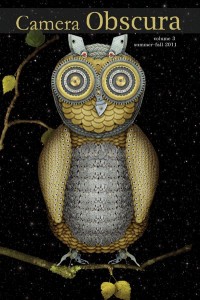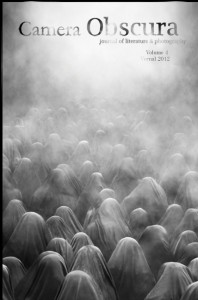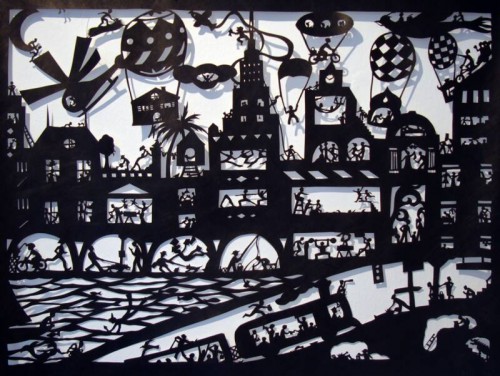Green Lights by Kyle Muntz
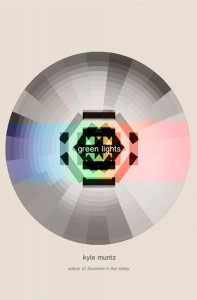 Green Lights
Green Lights
by Kyle Muntz
Civil Coping Mechanisms, May 2014
108 pages / $13.95 Buy from Amazon
In Kyle Muntz’s Green Lights, we’re exposed to wavelengths as beams of prose, an unnamed narrator whose world is flooded in the disparate hues of existence. There’s a meditative quality throughout, a detachment borne of Kafkaesque inquiry and a yearning for communication that teeters on the fiat lux’s of every day creation. Not just through visible light, but the invisible nanometers that escape normal sight. “I want to talk about color,” the book begins, and the colors of the spectrum quickly become a metaphor for revelation and metamorphosis. The characters, from the moon turned into a woman, to an old man embodying evil, become symbolic accoutrements for the journey which turns out to be an excursion to another dimension. Elements of the fantastic shine as in the “Blue” chapter when the whole neighborhood is covered in noirish film shades that masquerade as night, and then, “The world froze… Ice had taken over the world.” Winter isn’t just the congealing of the veins and muscles, but a coat of futility wrapped around his routine actions. “After much effort, I thawed my room. I’m not proud of the things I did to accomplish this,” he confesses, then further reveals, “I got a job carrying a flamethrower around the neighborhood, melting people. My coworkers treated me like shit.” The frost of survival is just as bleak as the cold treatment of his colleagues and the blending of colors weaves the conflagration of pain with the inferno of transformation.
There’s a melodic beat to Muntz’s writing, terse descriptions of events interspersed with sudden bursts of graphic visuals, often macabre in its evocations. It’s a delicate balance, but one he masterfully navigates, exploiting minimalism to maximize emotional defibrillations, injecting the grotesque to animate the mundane:
“One time when I was walking in the darkness, I stumbled over something, and it was him, sprawled on the ground, unable to move. He didn’t have eyes anymore. Maggots crawled amidst the remnants of his skin, fibrous muscles like totted spaghetti. Worms fucked his intestines. Beetles were chewing his brains.”
Like signal lights, there’s a revolving flow of ideas that are given free rein and then brought to a halting stop, warning yellows demarcating the blurry boundaries between illusion and reality. That border is often where Muntz’s narrator lingers, rarely surprised by the absurdity of the surreal events that happen around him, instead, levitating past the barriers. It’s almost as though the green light were always on and physics broken free of limitations to innovate. Muntz revels in experimentation, relishes the opportunities to change up the traditional narrative as he bakes x-rays of playful contemplations into the atlas of his construction:
“Sometimes when I looked into the distance, I remembered that the darkness I could see there was actually the mountain, holding up the base of the universe. If I were to walk that way, the neighborhood would never end, but eventually it would become less real… The road continued even where the world began to change colors.”
His main companion is his love interest, E, who is as curious as the narrator about the frontier, a geography that challenges the intellectual as much as the physical. Both are intertwined and both affect each other, a symbiotic terraforming that is volcanic in its effect.
“Nearby, behind an abandoned house, we found an immense flower growing from the ground. The flower was at least a hundred feet tall. Beads of water clung to its sides… She nodded. ‘It looks like a picture of itself, meaning it looks better than real. That means something. It implies amazingness.’
‘Should we climb it?’
‘Probably,’ she said. ‘If we didn’t, we would feel bad about it later.’”
There’s a lot of climbing in Green Lights and like E, we know we’d feel bad if we didn’t venture upward. Along the way, we get dashes of the videogame classic, Earthbound, embedded with David Lynch, Borges, and doses of Marquez. The combination acts as a variety of hues to assault our senses in this quirky and likable hike while at the same time, Muntz weaves his own identity through the narrative. I just wish there were more colors in the spectrum.
***
Peter Tieryas Liu is the author of Bald New World and Watering Heaven. He entropies at entropymag.org. He loves green lights. And red ones. And blue ones too.
July 21st, 2014 / 10:00 am
Bald New World by Peter Tieryas Liu
 Bald New World
Bald New World
by Peter Tieryas Liu
Perfect Edge, May 2014
229 pages / $16.95 Pre-order from Amazon
Having been thrilled by the imagination in his short story collection, Watering Heaven, I was excited to see Peter Tieryas Liu was taking on a larger work: his new novel Bald New World. The play in the title on the canonical dystopian work by Huxley only further stimulated my appetite.
How would it be handled? Would it be playful? Would it be strange? Would it be dystopian? Yes, yes to all those things (other than the one that isn’t a yes/no question):
As the title suggests, everyone has mysteriously gone bald. One would hope that people would learn to live with baldness, since no one has any hair. However, we should all know human nature better than that by now. Superficial, vain, and capable of endless denial. There are riots, chaos. This goes hand in hand with the actual problems in the world: overpopulation, diminishing food supplies, wars over resources, and so on. Wig companies dominate the global economy.
As one would demand in a dystopian novel, life becomes even more hellish than it already is. Body modification, visits to the United States (though most of the book takes place in China) fraught with the almost certainty of being shot, North Korea kidnapping people from other countries to be slaves in forced labor camps, and more. The term ‘dystopian’ certainly fits.
Within all of this, we have Nick. Nick has spent his life trying to cut himself free from a horribly abusive family…trying to be free. Modernly, he’s a filmmaker:
His friend and employer, Larry, is the heir to the world’s most powerful wig corporation. He’s also somewhat of a fuckup.
However, something particularly strange is going on. Larry may be in over his head, caught up in a conspiracy with far-reaching and possibly deadly consequences. At the heart may be the very secret behind why everyone went bald. Of course, he pulls Nick in. Things wouldn’t be very interesting if he didn’t:
He laughed. “Maybe I’m being a touch melodramatic. Beautiful women always do that to me. Let’s give it one more shot. This new film I was mentioning. It’ll be the biggest ever.”
“Can you give more details?”
“At first, I thought maybe I’d do a documentary about my family. Or maybe I’d make it into a film about a rich family with an idiot son who squandered everything. Would that be too cliché? I don’t want to be that idiot,” he said. “I’m starting to settle on one idea.”
“What is it?”
“I’ve always wanted to do an epic about the Baldification. Maybe call it Bald New World. Do a film about the people in it. It’ll be massive. I guarantee you. This’ll be the film that everyone notices.”
“No one’s figured out what exactly happened yet.”
“That’s what the businesses would like people to think,” Larry said. “What if I told you people like my father knew exactly what happened?
“What do you mean?”
“Well—”
Behind us, one of the factories exploded, blowing the plates off the table and knocking us both back. A second factory blew up, the fire blasting against our faces. My ears were ringing and the smoke made everything hazy. I heard a third boom but couldn’t tell where it was from. Sirens were ringing.
April 4th, 2014 / 11:00 am
Use of Weapons by Iain M. Banks
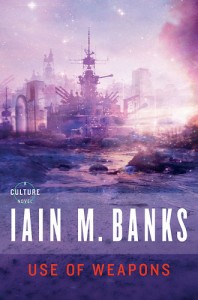 Use of Weapons (Culture Series)
Use of Weapons (Culture Series)
by Iain M. Banks
Orbit; Reprint edition, July 2008
512 pages / $15.99 Buy from Amazon
The Culture series by Iain M. Banks just keeps on getting better and in Use of Weapons, the narrative takes on added complexity in a two-pronged narrative that intertwines the tale of a hunter, Zakalwe, who has left the Culture and a woman, Sma, who still works for them. I’d go so far as to say this is one of the most experimental works by Banks, or for that matter, any science fiction writer, particularly in light of the ending. Because of its added intricacy, I (PTL) invited Joseph Michael Owens (JMO) and Kyle Muntz (KM) to collaboratively review the book and share/debate/spur our thoughts in a “cultural” exchange.
Peter Tieryas Liu: What was your take on Zakalwe and Sma in the pantheon of Culture characters?
Joseph Michael Owens: To be honest, Cheradine Zakalwe and Diziet Sma are probably two of my very favorite Culture characters overall, and I’m currently reading the last book in the series. The chemistry between them is truly fantastic. It’s hard to explain without giving away major spoilers, but you’ve got a really fantastic setup where you can see there is a great detail of history between them and it’s 100% believable. You can feel that they know each other incredibly well and, in some situations, they’re really the only ones that can handle each other.
Banks is also good with layering characters’ roles, and you get the feeling that both Zakalwe and Sma have done and seen a lot that doesn’t necessarily have to do with their current occupations, which I love. I think it adds an extra human element to the characters, these two specifically, because we’re shown that they exist — and have existed — outside of this single narrative. And since they feel like people and thus read like people.
The ending is . . . it’s just wow. . . .
Kyle Muntz: I’m not sure I can add too much to Joe’s comments (since I think that’s totally on-base and right), but in retrospect, I’d say Diziet Sma in particular has really stuck with me. The Culture series has a lot of strong female characters, but Sma is definitely one of the most interesting and best realized. For me, one thing the experimental elements of the novel call attention to (by telling Zakalwe’s story forwards and backwards at the same time) is how broad life is; and how separate different episodes in it can be. Especially when the chronology is destabilized. The novel gives glimpses of the same people, years apart–and each time they seem different, sometimes almost unrecognizable. And that’s life.
Use of Weapons is the last Culture novel to focus on a small cast of characters. After this, it becomes a sequence of vaguely Pynchonian ensemble pieces, and while I love the broader scope that brings to the series, it makes me appreciate the more intimate characterizations of the earlier novels, especially this and Player of Games. Characterization wise I think Banks is in top form here. In general, every Culture novel is unique, but formally none of them stand apart as strongly as Use of Weapons.
PTL: One of the most interesting chapters is when Banks’ describes Zakalwe’s first time aboard a Culture ship, Size Isn’t Everything. It’s our first real exposure from the eyes of a newcomer to how different the Culture is from everything we know, particularly with a post-scarcity economy in which anyone can do what they want.
One of the dialogues I remember is a waiter who talks about what’s important in life and why he enjoys wiping tables when he can do anything he wants: “I could try composing wonderful musical works or day-longer entertainment epics, but what would that do? Give people pleasure? My wiping this table gives me pleasure. And people come to a clean table, which gives them pleasure. And anyways, people die; stars die; universes die. What is any achievement, however great it was, once time itself is dead?” What do you guys think about the Culture? Things you like and dislike?
JMO: I remember Banks saying once that he modeled the Culture off of his ideal utopia, which is kind of cool because that’s an example of the power of writing and creativity: you can literally create your own world, and then go play in it! There’s really nothing I dislike about the Culture; I’m like the ultimate Culture fanboy. The way I’ve read it since book 1 (Consider Phlebas) is that a pan-human race created AIs that were able to perpetuate and evolve themselves into the Minds we know and love in current Culture novels. The AIs basically take care of all the mundane activities for humans so that humans can dedicate themselves to whatever they want: art, recreation, education, various experiences in general. Disease has been eradicated in the biological citizens, and people can augment themselves any number of ways they desire for utility or for fun. This sounds totally like a place I’d want to live!
KM: There’s a certain amount of tension within the novels about the Culture, mostly questioning how such a powerful, secular, completely free, post-violence, post-scarcity society (controlled entirely by machines) should interact with violent, oppressive, warfaring societies who rule themselves and do a terrible job of it. But I think the Culture is objectively pretty perfect.
I read the series over a year ago now, but it was the setting that kept me coming back: the Culture, endless, unchanging, as a place to live and way of life to be explored. Genre fiction tends to treat society as something to be moved: societies fight war, are saved from corruption, whatever. Which I’ve always thought was boring, and pushes me away from series like Song of Ice and Fire. Instead, the Culture is basically incorruptible and one of the most intellectually sound utopias in fiction. (Another good example is Triton by Samuel Delany.) There are elements of the setting I still think about pretty regularly, and in retrospect even echo through a novel I wrote called The Holy Ghost, which was about a utopian-ish society that did have to deal with scarcity.
Another main tension is always going to be that the Culture isn’t run by people — it’s run by machines infinitely smarter and, yes, more humane than we’ve ever been. This isn’t something I’d want to dive too deeply into, other than to say: I don’t really see the problem.
PTL: The contrast between the Federation (e.g.) in Star Trek and the Culture is fascinating in that while both are postscarity, the latter embraces human nature to an extreme while the Federation espouses a future in which human nature is transcended. Sma is casual about her sexual liaisons with crew members and all hints of traditional morality are banished, whereas in the Federation, conservative values are still very prevalent. But the biggest difference is that the Minds run the Culture whereas the Federation has a council that is susceptible to corruption. So in that sense, the Culture could not exist if it weren’t for the Minds and Artificial Brains that are in control. Beychae, the target of Zakalwe’s chase, poses an interesting thought: “The Culture believes profoundly in machine sentience, so it thinks everyone ought to, but I think it also believes every civilization should be run by its machines.” Zakalwe replies: “I have no idea whether they’re the good guys or not… They certainly seem to be, but then who knows that seeming is being? I have never seen them be cruel, even when they might have claimed they have an excuse to do so. It can make them seem cold, sometimes. But there are folks that’ll tell you it’s the bad gods that always have the most beautiful faces and the softest voices.”
In some ways, these “Artificial” Minds are the future gods, albeit quirky and eclectic ones. Do you think there’s an assumption by Banks that humans can’t achieve this totally peaceful society by their own means and need someone else in control? For all practical matters, if there were a master species of aliens that were also benevolent, they could easily take the place of the Minds in the fiction (though that probably would have been harder to swallow for human readers who would equate it to human slavery).
JMO: I like the Minds-as-future-gods idea because to us, they would be, especially given that they (i.e. the Culture) are a level 8 civilization. However, there are also level 9 and 10 civs out there (10 being those civs that have Sublimed, if I recall), who are ostensibly gods even to the Culture and other level 7-8 civs. This is something you are even given an example of in the final Culture novel, The Hydrogen Sonata, when one Mind talks to another that has actually returned to “the Real” from the Sublime (something that is almost unheard of).
Also, I got this from a wiki: “Also significant within the Culture novel cycle is that the book shows a number of Minds acting in a decidedly non-benevolent way, somewhat qualifying the godlike non-corruptibility and benevolence they are ascribed in other Culture novels. Banks himself has described the actions of some of the Minds in the novel as akin to “barbarian kings presented with the promise of gold in the hills”.”
I think the idea is that, once Sublimed, you are fully actualized within the greater universe. One of the feelings you get, however, is that Subliming is something civilizations also do when they — for lack of a better term — get bored, and decide simply to “retire.”
To go with your main question, I think as long as there is a sense of “us” and “them,” or more specifically, “the other” — and as long as there are resources that are not available to everyone — it will be incredibly hard for humans to achieve such a totally peaceful society by their own means. Humans are inherently opportunistic, even when they have the best intentions. As long as someone else has something you want, you’ll likely experience some level of envy. Oftentimes the sense of envy will be manageable, but what happens when it’s not, i.e. in situations where what you want involves feeding starving people? Of course that’s a base need versus simple want, but when resources become scarce, the line gets blurry.
December 30th, 2013 / 11:00 am
Video Review of The Natural Dissolution of Fleeting Improvised Men by Gabriel Blackwell
Trays of live worms for consumption, a nightly stroll with the shells of dead animals, and an arm covered in yogurt and soy sauce that smelled like strawberry grease for a whole afternoon; these are the ingredients for this new video book review of Gabriel Blackwell’s book by Gabriel Blackwell and meta-Gabriel Blackwell from CCM. I don’t know which of them is real. I think I’ve been hypnotized by Joseph Michael Owens’ music tracks. But I didn’t make this video. My wife did. She says she’s never seen any of the footage included and doesn’t understand why I’m crediting her. I don’t like strawberry soy sauce covering my arm so that my hands are unctuously melting into my chest. I’ve never eaten living worms before. I need to go back to America and have cheeseburgers made of artificial cheese and meat so I can have a culinary epiphany and shit out truths inspired by film cuts of scatological epics. You should read The Natural Dissolution of Fleeting-Improvised Men from CCM by Gabriel Blackwell reviewed by Peter Tieryas Liu and Angela Xu with music from Joseph Michael Owens and edited by Janice Lee.
(Read the previous review on HTMLGIANT here)
November 7th, 2013 / 11:49 am
Interview with Christine Lee Zilka and Jennifer Derilo of the Kartika Review
I’ve always been curious about the darkroom where literary magazines come together. This is a series of interviews engaging, talking, and sometimes annoying editors about their magazines. How did they come about, what do they hate about editing, and what do they love most about it?
This is the third in the series and I talked with Fiction Editor, Christine Lee Zilka, and Creative Nonfiction editor, Jennifer Derilo. Their about page has the following description: “Kartika Review is a national literary arts magazine that publishes Asian Pacific Islander American fiction, poetry, creative non-fiction, and art. Kartika Review serves the Asian Pacific Islander American (APIA) community and those involved with Diasporic Asian and Pacific Islander-inspired literature. We scout for compelling APIA creative writing and artwork to present to the public at large. Our editors actively solicit contributions from established virtuosos in our community in hopes their works here will inspire the next generation of virtuosos. Kartika also promotes emerging writers and artists we foresee to be the future powerhouses of their craft. Ultimately, Kartika strives to create a literary forum that caters to and celebrates the wordsmiths of the Asian Diaspora.”
What’s always drawn me to the review is their focus on great stories. The APIA experience is incredibly diverse and the Kartika Review pushes the boundaries of what constitutes APIA literature. The settings may differ and so may some of the sentiments of the narrators, but at the core, the emotional resonance transcends any differences. The tales, poetry, essays, and imagery form a unique flotilla of art that is as portable as it is relatable. I hopped on board with the two editors and what followed was an organic and fun trek through the editorial rivers of the review.
***
As a brief bio and introduction to Christine (CLZ) and Jennifer (JD):

Christine Lee Zilka is the Fiction Editor at KARTIKA REVIEW. Her work has appeared in journals and anthologies such as ZYZZYVA, GUERNICA, VERBSAP, HYPHEN, and MEN UNDRESSED. She has a novel in progress.

Jennifer Derilo is the Creative Nonfiction editor at Kartika Review. She has a memoir in progress. She often has nightmares about zombies. And abandoned predicate parts.
***
PTL: When and how did you first get involved with Kartika Review?
CLZ: I subbed a short story for consideration to Kartika in early 2008–and I got an email from Sunny Woan, our Founding Editor, saying she loved the piece and wanted to know if I would be interested in becoming Kartika’s Fiction Editor (the previous Fiction Editors departed after Kartika’s second issue). I told her yes! It was my call whether or not to have the piece published; I’m not a big proponent of editors publishing their own work at the litmag for which they work, so I withdrew the piece. The rest is history. I found a passion project in Kartika Review and a fantastic friend in Sunny. And recently, that story just got accepted for publication in another litmag. I owe a lot to that story.
JD: Christine and I were in the MFA program at Mills, but she was in the cohort ahead of me. I first met her when she was the TA for a teaching pedagogy class during my first semester in 2006. While she was an excellent TA, she also coaxed me out of my shell. I started to see her as a big sister type who had the best advice about classes, professors, the program itself, and eventually writing. We kept in touch after we both graduated (I kept going to her for advice!), and then sometime in 2008, Christine asked me to submit something to KR, but in true Jenn Derilo fashion, I never did. And then in 2009, she asked me to join because the CNF editor before me was moving onto other things. I’m sorry for all that backstory about my friendship with Christine, but if I didn’t initially glom onto her (ok…that’s not supposed to sound as creepy, stalker-ish, aggressive as it might), I don’t know that I would ever have been exposed to KR. I was such a writing/literary n00b when I started Mills, and I certainly knew nothing about APIA literature. But she talked about Kartika with such passion, and I was so impressed with the work they were doing, I couldn’t not join. I was supremely honored.
CZ: Jenn is modest. She’s an awesome writer. And has done amazing things as an editor at Kartika.
JD: Aw, shucks. Thank you. I’m lucky to be on an editorial board with multi-talented women of color. And I can’t stress that enough: women of color.
PTL: Christine, I really liked it when you said in regards to your editorial selections: “I often pick pieces by Asian Americans that aren’t API-centric. There are no rules, and Naomi Williams breaks them with brilliance.” What are some works that you both think exemplify Asian Pacific Islander American (APIA) literature, and how did those works affect and influence you?
CLZ: Twenty years ago, this question would have had a more clear cut answer. I would probably have said Maxine Hong Kingston’s WOMAN WARRIOR or Chang-rae Lee’s NATIVE SPEAKER. To that end, I’m motivated both as a writer and as an editor to broaden APIA literature. I’m happy to say there’s no single work that stands out to me, anymore. And I’m also happy that I’m a gatekeeper who gets to have a hand in diversifying the pool. I’m in front of a verrrry small gate, but it’s a gate, nonetheless.
JD: While I know this question is directed at Christine, I can’t help jumping in and agreeing with her, especially given that my knowledge of APIA literature was limited before joining KR. I even knew little about the APIA cannon. But what we do at KR is different. I do feel like we’re “diversifying the pool”, such as including the work of emerging writers alongside interviews with household names. We aren’t only publishing APIA writers who engage with APIA themes. I think Christine nails it when she says, “I’m happy to say that there’s no single work that stands out to me, anymore.” I mean, wow. What a brave discovery to voice! This is not to say that no submissions stand out because, clearly, we publish those pieces shake us. What’s important about that statement is that no one work encapsulates, defines, pigeonholes APIA literature. Rather each work broadens this scope.
PTL: I love the definition of “Kartika” as mentioned on the site: “In Vajrayana (or Tibetan) Buddhist tradition, the kartika, a crescent-shaped knife, symbolizes the cutting away of ignorance and superficiality, with the hopes that it will lead to enlightenment.” What are some themes and elements you both look for in the selections you make for short stories and non-fiction essays?
JD: I don’t know if this is cliche, but I’m attracted to creative nonfiction that surprises me. Even if submissions are about common themes, if the approach to language, structure, or voice is undeniably fresh or risky, I quickly gravitate toward them. It’s difficult to pinpoint exactly what floors me. The best way to understand my madness is to read our back issues starting with #6, which is, of course, when I joined.
CLZ: When I’m looking through the slushpile, pieces tend to blur into each other—so I too, am looking for something different. I’m looking for stories that hit something out of the ballpark, be it concept, structure, language, or ultimately, story. What haven’t I seen before?
Interview with M.E. Parker of the Camera Obscura Journal of Literature & Photography
I’ve always been curious about the darkroom where literary magazines come together. This is a series of interviews engaging, talking, and sometimes annoying editors about their magazines. How did they come about, what do they hate about editing, and what do they love most about it? This is the second in the series and I talked with M.E. Parker of the Camera Obscura Journal of Literature & Photography. It’s by far one of the most beautiful literary magazines around with riveting photography that goes hand-in-hand with some amazing voices. Seriously, the covers kick ass and the stories rip you open from inside and your guts are hanging out and you smile, “Cheese,” for the camera because you want to capture that brief moment where inspiration bisects into awe and mesmerized nausea from having been split open. A brief description on their site states they are: “an independent literary journal and internet haunt featuring contemporary literary fiction & photography. Contributors include established, as well as, emerging writers and photographers.”
As a brief bio and introduction to M.E. Parker:
M.E. Parker is a writer, an editor, web designer, and a carpenter who imagines a world of wooden computers with leather bound keyboards. His short fiction has come up for air in numerous print publications and Internet haunts. He is the founding Editor of Camera Obscura Journal of Literature & Photography. www.meparker.com
***
PTL: When and how did you first come up with the idea of starting the Camera Obscura Journal of Literature and Photography?
M.E. Parker: As is often the case with grand notions conceived in the mental stupor of Belgian Monk brewed beer, I first envisioned a glorious, indescribable tome, pared the following day by the limits of funds, time, and logistics with a few basic principles to guide it. Mostly I wanted a writer and artist friendly venue where, not only contributors, but submitters as well, really do come first, and the stress of the submission process gives way to levity. And in the process my hope was that we create a great community and journal and have fun on the journey (we are still the only journal with a big red “Bug the Editor” button on the withdraw/submit page).
As the editor, I assembled a team not unlike selecting a crew for a heist:
Me – Captain and story wrangler.
Shane Oshetski – can deconstruct, analyze and ostracize any short story.
Tim Horvath – erudite lover of language and Borges, who might wear tweed as an old man.
Meredith Doench – appreciates variety, enjoys the flaws, offsets Shane.
Kate – my wife and incredible photographer, master negotiator, foiler of plots.
PTL: The photography in the magazine is just incredible. What goes into the selection/curating process for the photographs? Are most/all of them chosen from the Competition?
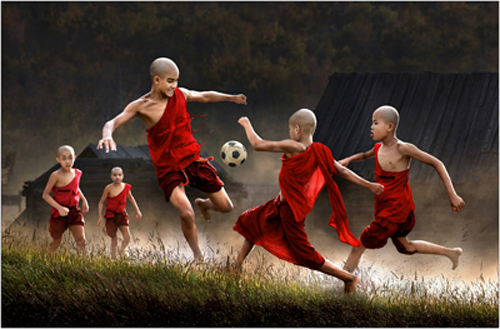
M.E. Parker: The photography does come from the competition for a variety of reasons. Rather than selecting artwork to showcase on the basis of appeal or to augment the writing as an accessory, I wanted a journal where the photography underwent the same editorial scrutiny and selection criteria as the writing without regard for prevailing aesthetic.
Interview with Angela Leroux-Lindsey of The Adirondack Review
I’ve always been curious about the darkroom where literary magazines come together. This is a series of interviews engaging, talking, and sometimes annoying editors about their magazines. How did they come about, what do they hate about editing, and what do they love most about it? This is the first in the series and I talked with Angela Leroux-Lindsey of The Adirondack Review. The visual imagery is simply stunning. The Adirondack Review is like an art gallery curated online, constantly evolving, fused together with great stories, poetry, and essays. In preparation for the interview, I pretty much went through the entire archives and got a brain dump, Matrix-style, in art and photography. A jolt to the system is what I like feeling with my lit magazines and reading directly from their about page: “The Adirondack Review is an independent online quarterly magazine of literature and the arts dedicated to publishing poetry, fiction, artwork, and photography, as well as interviews, articles, book reviews, and translations. Recently named a ‘great online literary magazine’ by Esquire and a ‘top online journal’ by The Huffington Post, TAR was established in the spring of 2000, with its first issue appearing that summer.”
As a brief bio and introduction to Angela Leroux-Lindsey:
Angela Leroux-Lindsey is editor of The Adirondack Review and senior editor with Black Lawrence Press. She writes for Kirkus Reviews and A&U Magazine, and has contributed essays and stories to phys.org, Animal Farm, Innovation Magazine, NY Metro, Brookhaven National Laboratory, and others. She lives in Brooklyn.
***
PTL: Can you tell us about the review, how did The Adirondack Review first get its inception and how did you first get involved?
Angela Leroux-Lindsey: The magazine has actually been around since the summer of 2000—the founder editor, Colleen Ryor, was sort of a pioneer in never going to print, which is something I’ve always admired. But I didn’t start contributing until 2006 or 2007. At that point Diane Goettel was editing, and when she left to run Black Lawrence Press full-time, I took over. So my first issue was in the winter of 2009. A big part of the appeal was their early commitment to publishing art. I especially love how being online gives us the freedom to publish as much full-color art as we want; in the fall issue, I featured almost 30 images by five different artists and photographers. This is something we could never afford if we had to pay for ink and paper. We also publish poetry, fiction, and works in translation in every issue, a mix of mediums that I think is really lovely. Every time we close I’m sort of delighted to see unexpected threads emerge that tie completely different submissions together: a drawing that evokes the tension of post-apocalyptic familial relationships next to a story that takes place on a placid lake over the course of an afternoon but is really about survival. Discovering these entanglements and bringing so many different people together is so much fun. It’s the best job.
PTL: Each issue is packed with fiction, poetry, and some of the most incredible photography and art I’ve seen. What goes into the curating and selection process?
ALL: Well, like every small lit mag out there, I rely so much on my staff. We all volunteer, which makes it even more amazing that I’ve found a group of people willing to be so thoughtful and imaginative about how we compose issues. Nick Samaras, our poetry editor, came on board when I did and he’s brilliant. Google him, read his poetry, you’ll just swoon over it.
Regarding art, some of it comes in through the submission process, but a lot of it I solicit. Sometimes I’m just scrolling through tumblr and come across a piece that floors me. And I’m always completely thrilled when a big name that I’ve solicited says yes: I mean, Manfred Mohr was on the cover of the summer issue. I was watching some of his animated videos from the 70s on YouTube, and figured I’d send him an email to ask if he’d be interested in featuring some of his new stuff. And he emailed me back within a week and said yes. I’m still excited every time this happens. It’s magical. Richard Mosse is another example. I’m in love with his INFRA series, which is online now.
Really, getting to work with all of these artists and writers is absolutely the best part of having this role. Not just meeting new people and developing friendships—like with you, Peter—which I really value. But living in Brooklyn and getting to hang out with so many writers I admire is killer. You wouldn’t believe the people I’ve met and fallen completely to pieces in front of. I hosted a reading once with Paul Muldoon and could hardly pronounce my own name when I introduced myself. And then to watch emerging writers and artists who have published work with us go on to publish books or exhibit work at major galleries or museums is really awesome. My friend Kit Frick has a completely gorgeous chapbook coming out called Echo, Echo, Light from Slope Editions. We published early versions of a few of these poems in 2011 and I can’t wait to see how they’re incorporated into a collection. And Luba Lukova, a political artist whose work I sought out for the cover of the first issue I edited, will show at MoMA next month. Revisiting these issues and experiencing that kind of folding of time is a cool thing. It makes me think of the larger view of independent publishing as a sort of performance art space in itself.
Video Review of Gabe Durham’s Fun Camp
Peter Tieryas Liu reviewed Fun Camp by Gabe Durham last week (read the review here), and now, in addition, Peter Tieryas Liu with Angela Xu have made this cool video review using some great archival footage from a 1950’s YMCA commercial. Check it out:
August 25th, 2013 / 11:36 am
Fun Camp by Gabe Durham
 Fun Camp
Fun Camp
by Gabe Durham
Publishing Genius, 2013
166 pages / $14.95 Buy from Publishing Genius
Summer camp as microcosm for society. Fun Camp by Gabe Durham acts as a strange microscope for the cabin of our lives. I used to go to summer camp and write journal entries every night detailing my experiences. Nostalgia overwhelmed me as I read through the letters, entries, stories, and logs that comprise Fun Camp. The bitterness and joy of the Bildungsroman is rendered as multiple epistolary works, the contrasts between the counselors and the students divvied up by metaphysical musings on camp life. The miracle is how much gets packed into that short period of time; falling in and out of love, friendships born and betrayed, philosophical schisms formed and patched:
“One week? So many sticky memories in such a disposal duration seems impossible. In seventy-five years, you’ll be grizzled on some hospital bed, leaning too hard on memories to divert you from a slow death, struggling to recall your husband’s name, hard-pressed to find a memory…”
The way the narrative flows is as much a character as the campers. The polylogic nature of the epistolary means the perspectives jump from counselor to students and back. Sometimes, satirical, other times, genuinely empathetic, the musings range from distantly sociological to sentimentally jarring. In some ways, it’s a novelized Chautauqua at a campfire set ablaze, albeit without the burnt marshmallows. Mosquitoes of doubt sting and the angst of hormones amplified to the nth degree adds to the quaint allure of story telling, parables meant to shed light on the madness of existence in a camp full of parent-less teens:
“Just as we once had slavery legalized, bees used to be carnivorous wasps. One theory has the wasps eating insects with pollen on them, acquiring a taste, then cutting out the middleman… Best to keep the bees at a distance like the sun and the ocean and trees and the sweatshops and my family and all the other things I’m told I need but don’t need close.”
From the “Sudden Imposition of Chores” to gossip about some of the attendees to water pistol fights to musings on the immoral morality of the evenings skits, it’s the collective nature of the narrative that evokes the sense of fun. In a sense, camp is the modernized rite of passage with its own set of obscure rules and invocations that would seem alien to outsiders. Liminality might seem less stringent than ancient days, and yet the pressure can often be just as daunting. Durham weaves dissonant threads together, reciting a chant of the whimsies, the trials, the intrigues, and the mini-epiphanies that characterize the ceremonies each of the kids undergo. Even the adults, who should know better, are oblivious, suggesting the disconnect between age and wisdom is wider than the students would like to comfortably fathom. The subdivisions are further split out into the days of the week like a Rolodex of memories on call. What binds them together? A communal swap of background sets:
“Human restlessness is such that I could slide open the door to the church Econoline, shout, “Who wants to drive around with busted AC looking for a no-ethanol gas station?” or “Who wants to go get free examinations from the unlicensed proctologist?”… and still I’d fill the van and leave a hoard of angry dust-kickers in my wake. Why? Because everybody knows the best camp activities are those rich with mnemonic potential, and memories remain longest when attached to changes of scenery. As in, ‘One time we piled into a van and…’”
August 19th, 2013 / 11:00 am
The Natural Dissolution of Fleeting-Improvised Men by Gabriel Blackwell
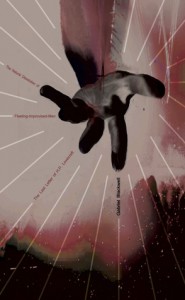 The Natural Dissolution of Fleeting-Improvised Men
The Natural Dissolution of Fleeting-Improvised Men
by Gabriel Blackwell
Civil Coping Mechanisms, Available October 2013
Gabriel Blackwell channels H.P. Lovecraft in The Natural Dissolution of Fleeting-Improvised Men, an epistolary metafiction that serves as part of a trilogy of works connected by his earlier Shadow Man and Critique of Pure Reason. In the introduction, Blackwell reveals that he has set out to Providence, Rhode Island, to find his girlfriend, Jessica, who disappeared while he was finishing the writing of Shadow Man. During that trek to Providence, he discovers the final letter of H.P. Lovecraft and that last message comprises most of the book in a footnoted poioumena intertwining his own desperate search with Lovecraft’s pestilential descent into madness. This isn’t just a pastiche of Lovecraft though, who died of intestinal cancer and whose last years were the most painfully productive. The mystery takes on a bizarre twist when he discovers the letter is addressed to another Gabriel Blackwell. Horror gets deconstructed and Lovecraft is retrofitted in a work that is less concerned with categorization than the ‘dissolution’ of existence. Experience itself becomes suspect as does the scholarship of pain. Blackwell, the meta character in the book versus the actual author, is typing out Lovecraft’s final letter. But as he does so, he is faced with a troubling revelation:
“That is, coming to the end of the particular sentence I was typing, I would look back over its analogue in the letter and would be unable to find even a third of what I had typed… This was undoubtedly made worse by the thicket of Lovecraft’s characters, by their lack of line breaks and paragraph breaks and even space between words, but it was also a quality of the prose. The events I was transcribing had not only not happened in life but not happened in the letter, either.”
It’s a setup for a mystery, a noir doused in elements of phantasmagoria with a magical lantern projecting Blackwell’s prose. The events described within are as gruesome and macabre as a Lovecraft story and in fact could be mistaken for one of his short stories. Horrible things are happening to the people in Lovecraft’s vicinity as in “this disgusting pile” that “was the remains of a man after he had been devoured and regurgitated by some horrid fungus or slime mold!” The grippe in his belly is devouring him from within and his mental state is corrupted into a decay and darkness that overwhelms his vision as much as his being:
“This thing in the basement was some sort of central node, a convergence of nerves. It was dowered with dark properties and obedient to dark laws; darkness was its element as air is the cloud’s, as water is the sea’s- the clashing, gnashing plates of its existence, in all of their horrifying splendor, were not so much dark as in aspect as of the dark…”
What adds a twist and requires a philological scalpel are the footnotes Blackwell uses to annotate his transcription of the letter. Much of the notes involves further elaboration of the plot details he outlines in his introduction. But there are disturbing intimations that require deciphering, a linguistic sonar to extrapolate from the echoes of meta-Blackwell’s journey. As his pursuit of Jessica becomes more desperate, his physical plight degenerates in a downward progression similar to Lovecraft’s. He is starving, cold, and suffering anemia. His body gets soaked with ink to the point where he does not recognize himself. With his impoverishment, things only get worse:
“I had a chronic inflammation around my anus- it itched all of the time and stung like a cut doused with hydrogen peroxide when wetted. I worried that I had soiled myself because of the wetness there, but always it was only blood.”
August 12th, 2013 / 11:00 am

